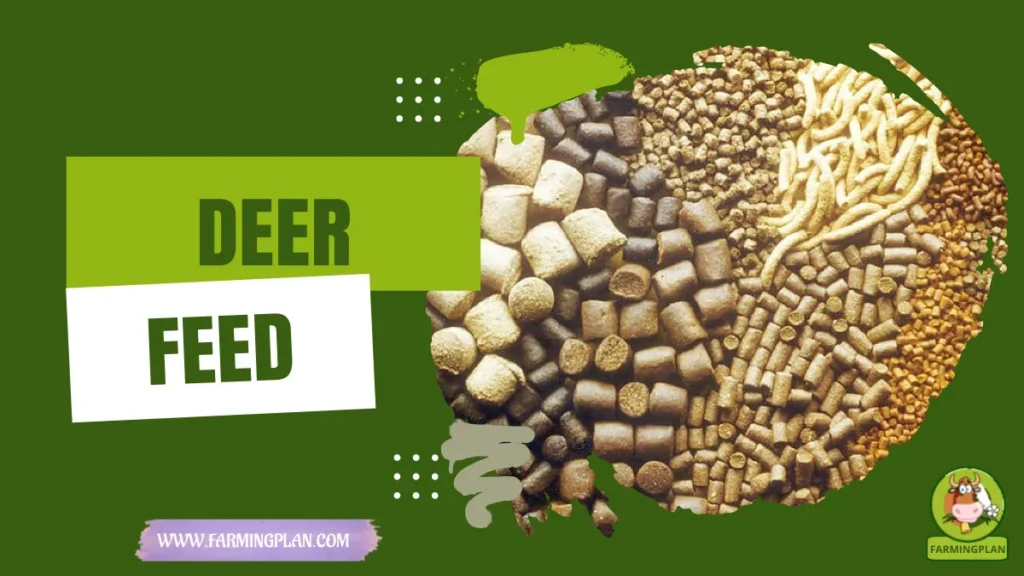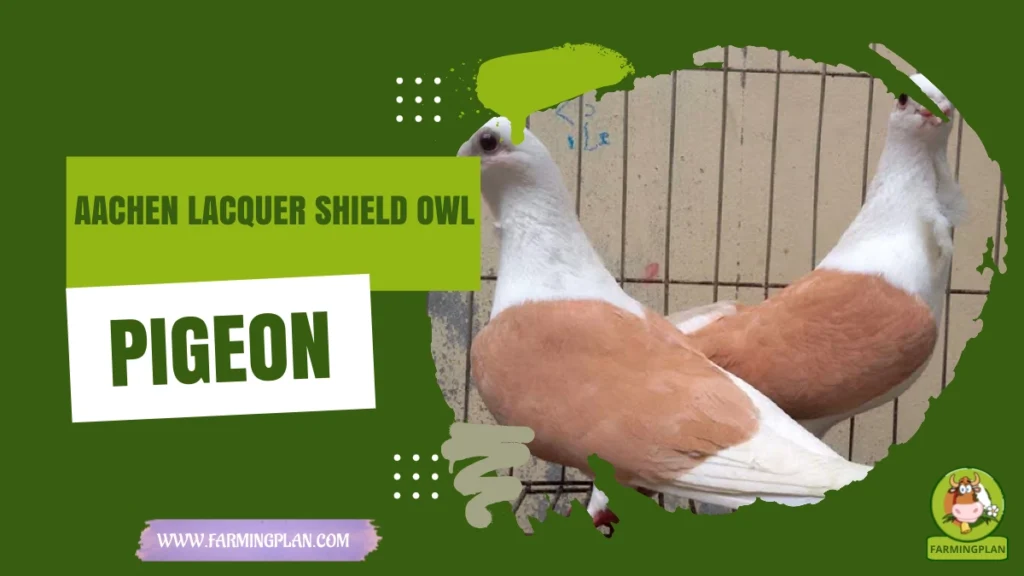Have you ever met a horse that feels like a luxury car on four legs? That was my first impression of the Spotted Saddle Horse. With their smooth gaits and eye-catching coat patterns, these horses aren’t just beautiful and built for comfort and connection. Whether you’re hitting the trails or need a gentle companion around the farm, this gaited breed shines in all the right ways. In this article, I’m walking you through everything I’ve learned from raising these charming horses, from their origin to feeding needs, and even a step-by-step care guide. Let’s dive into the world of the Spotted Saddle Horse together.
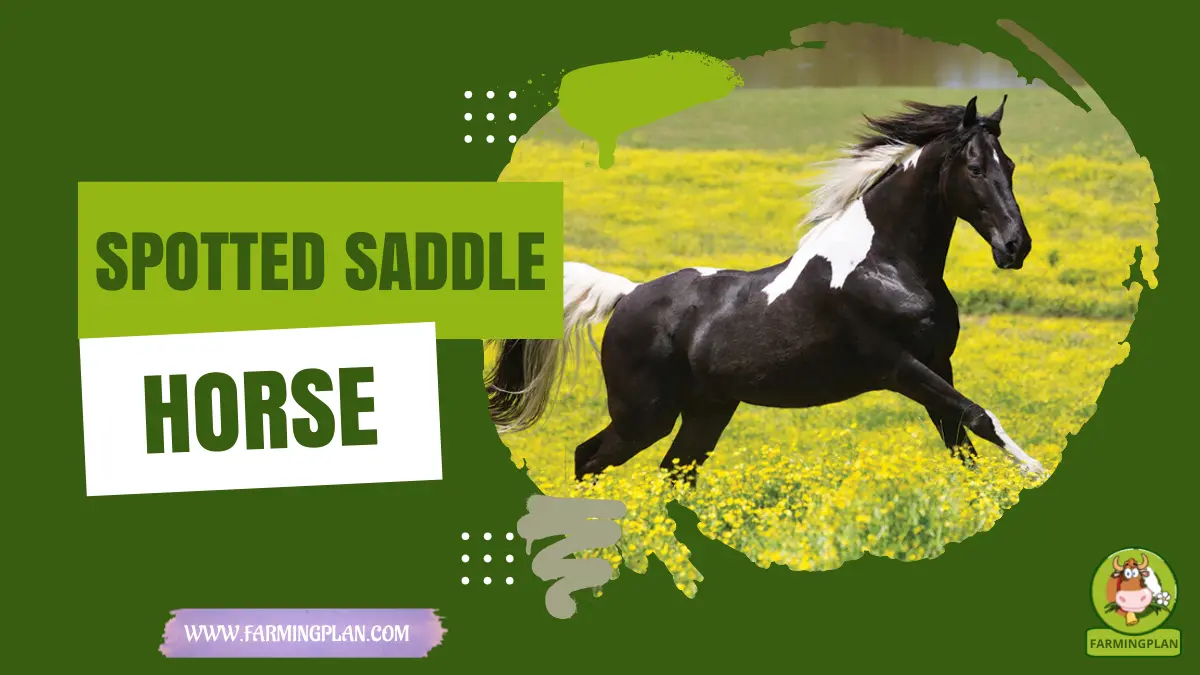
History & Origin Of The Spotted Saddle Horse
The Spotted Saddle Horse has deep roots in American soil. They were initially bred by combining Spanish horse populations with local American breeds like the American Mustang, Tennessee Walking Horse, and Thoroughbred Horses. The goal? To create a colorful, smooth-gaited horse perfect for riding long distances without the bounce.

As time passed, breeders focused on developing two main traits: comfort and coat pattern. That meant bringing in Missouri Fox Trotters and other gaited breeds to refine their smooth movements. Their popularity skyrocketed by the late 20th century, especially in the southeastern United States. This led to the Spotted Saddle Horse Association, a non-profit registry preserving the breed’s quality and uniqueness. Today, they’re prized in trail riding, field trial events, and as family-friendly companions.
Characteristics Of A Spotted Saddle Horse
These horses are downright show-stoppers. With coat patterns that include a broad spectrum of colors, they often sport bold white markings across their bodies, especially from the neck to the rump. One of my mares, a Bay Spotted Saddle Horse Mare, has dazzling contrast that turns heads everywhere we go.
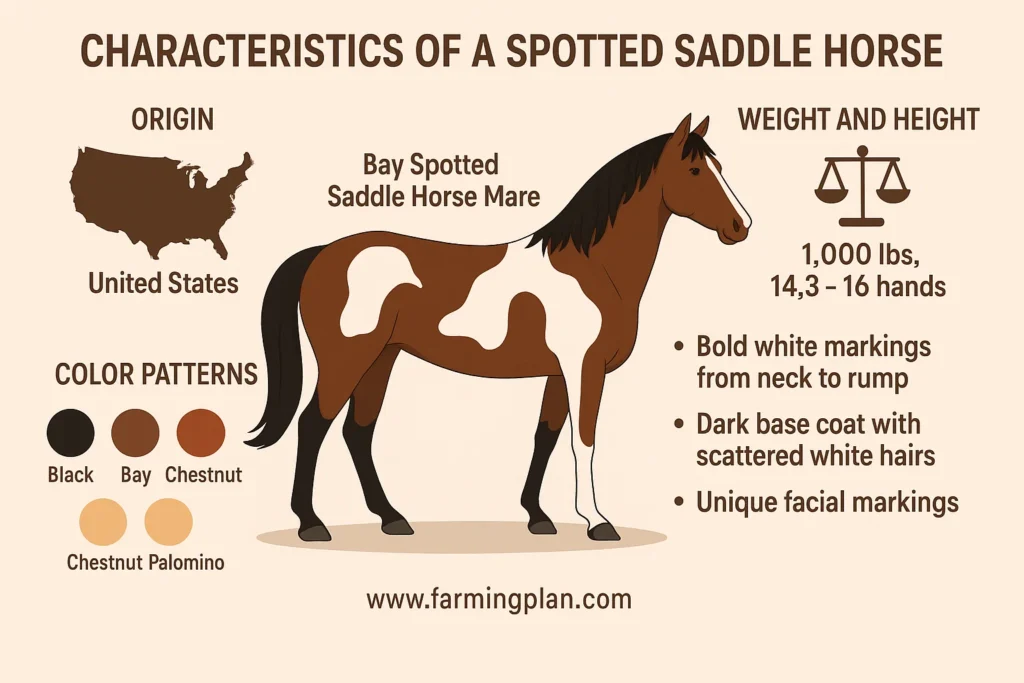
You’ll typically see combinations of dark color bases with scattered white hairs and unique facial markings. Their base coat color could be black, bay, chestnut, or even palomino—as long as there’s that unmistakable splash of color. On average, they weigh around 1,000 pounds and stand between 14.3 to 16 hands tall. They’re sturdy but not bulky, with enough muscle health to handle long rides while still looking graceful.
Spotted Saddle Horse Temperament & Behavior
If you’re looking for a horse just as sweet as it is stunning, you’ve come to the right breed. The Spotted Saddle Horse has a naturally friendly temperament and a gentle disposition, which makes them ideal for beginner riders, kids, and even folks exploring therapeutic riding programs.
In my experience, they’re curious, social, and easy to train—they thrive on human interaction. You can leave them in a calm family environment, and they’ll return the favor with loyalty and affection. These horses don’t spook easily, so they’re fantastic for trail riding in unpredictable terrain.
Read More: Plantation Horse: The Ultimate Ride for Comfort and Distance
Food & Diet For Optimal Horse Health
Nutrition is the backbone of a happy horse. I ensure my Spotted Saddle Horses have free-choice access to hay and unrestricted pasture access. This helps maintain good digestive health, supports hindgut health, and promotes strong immune health.
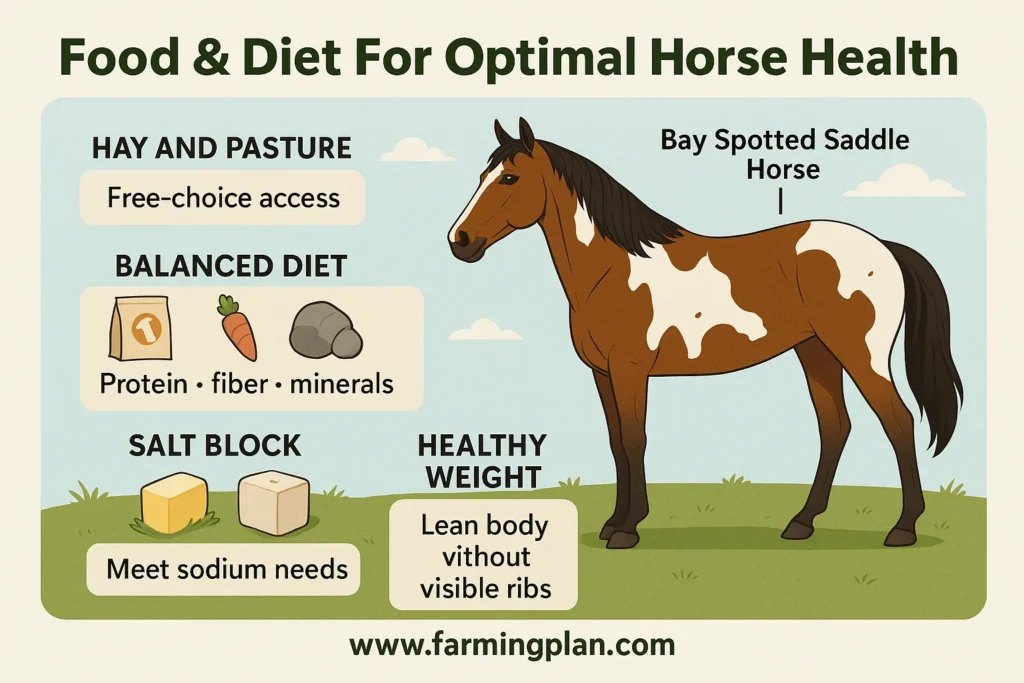
They require a balanced mix of protein, fiber, and minerals. Don’t overlook their sodium requirements either—I always keep salt blocks nearby. Monitor for excess weight gain, especially if they’re not in regular work. A healthy horse should maintain a lean body without visible ribs. Stick to a feeding schedule and consult your vet for tailored nutritional requirements.
What Is The Spotted Saddle Horse Used For?
These horses are true all-rounders. You’ll see them in Spotted Saddle Horse shows, field trial events, and long weekend trail rides. Their comfortable gaits mean you can spend hours in the saddle without feeling beat up afterward.
Many riders, especially those who don’t want to compete, enjoy them as non-racing performance horses. They’re also commonly chosen as keeper horses because of their good nature and flashy appearance. Whether for work, pleasure, or companionship, these horses never disappoint.
Special Features That Make Them Stand Out
What sets these beauties apart? First, their signature intermediate gait is smoother than a trot and easier on your joints. That alone makes them ideal for older riders or folks with back issues.
Then there’s the look—those vibrant coat color patterns, white markings, and bold contrasts make them total head-turners. Genetically, they carry the KIT and endothelin-B receptor genes, contributing to their spotting and color intensity. I’ve owned a few spotted gaited horses, but none with the poise and charm of the Spotted Saddle.
Read More: Rocky Mountain Horse: The Secret to Unleashing Unmatched Strength and Grace
Health Issues And Preventive Care
While generally hardy, horses do have some common health issues. Horses with prominent white markings may be more prone to sunburn or skin irritations. Look for patchy hair, redness, or unusual scratching.
Joint care is essential, too, especially if your horse participates in intense competition schedules. I rotate pasture time with light work and ensure they get regular vet checks. Don’t forget basic horse care like hoof trimming, worming, and vaccinations. Prevention is key when you want your horse to stay strong and sound.
Step-By-Step Pet Owner Care Guide
Get hands-on with my personal care routine for Spotted Saddle Horses. This practical, easy-to-follow guide covers everything from shelter setup to vet check-ups—based on real-life experience, not just theory. Whether new to horses or need a refresher, this five-step plan will help you build a safe, happy, and thriving home for your gaited friend.
Step 1: Set Up A Safe, Comfortable Shelter
When I bring a new Spotted Saddle Horse home, I always start by prepping their shelter. A dry, well-ventilated barn is a must. These horses are prone to respiratory issues if exposed to poor air quality or damp conditions. I lay soft straw or wood shavings for bedding and never skip daily stall cleaning. It keeps the space fresh and reduces harmful ammonia buildup from urine.
Outdoors, I rely on secure fencing—no barbed wire and no shortcuts. These curious, active horses love to explore, and one loose board can lead to an unexpected adventure down the road. I add shade with natural trees or a run-in shed, especially during hot summer days. I do a fence inspection every two weeks, walking the perimeter with a hammer. Prevention is always easier than a chase.
Step 2: Maintain A Healthy Feeding Routine
Good horse care is based on having a solid feeding schedule. The first thing I do in the morning is feed my horse grain chosen for their energy needs and add some hay which they always enjoy. Because alfalfa provides lots of protein, it’s ideal for staying healthy, energized, and fit without eating too much. At night, I feed my pet Hay, which has a lower level of starches, which is better for their metabolic and intestinal wellness.
It is good that cows can move freely to pasture, but this may lead to them gaining too much weight. Ensuring that the pets have a natural sodium source, I always put salt licks in their stall and pasture. As soon as there is a baby belly, I give them smaller portions and make them walk more.
Step 3: Prioritize Daily Grooming And Bonding
Grooming time is bonding time—and my daily check-up rolled into one. I start with a curry comb, working from neck to rump, watching for ticks, cuts, swelling, or patches of hair loss. Spotted saddle horses have striking coat patterns and facial markings that change and are easy to spot if you pay attention. Cleaning hooves is non-negotiable. I pick them before and after every ride to avoid stone bruises, thrush, or worse. But here’s my favorite part—I take my time. I talk to them, touch their ears and tail, and get them used to human contact. This daily habit helps build trust, making future vet visits, shows, or farrier work less stressful for everyone.
Step 4: Exercise And Ride Smart
These horses weren’t built to sit around. I ride mine three to four times weekly, usually on trails where their comfortable gaits shine. If I don’t ride, I do groundwork—lunging, obstacle work, or even liberty games. Movement keeps their joints, muscles, and minds in good shape. It’s tempting to push them, especially when they’re eager and athletic, but slow and steady wins every time. I warm them up with a gentle walk and cool them down the same way. A short session done right beats an intense one that risks injury. Their natural gaited movement means less bounce and more glide, perfect for adult riders and even beginners who want a smooth ride.
Step 5: Schedule Routine Vet And Farrier Visits
You can’t skip the vet and farrier. I book quarterly vet visits to update vaccines, float teeth, and run fecal tests for deworming plans. Dental care is often overlooked but can affect everything from weight to behavior.
As for hooves? I’ve learned the hard way—never miss a farrier appointment. I schedule trims every 6 to 8 weeks, whether my horse is barefoot or shod. Healthy hooves support gait, posture, and overall movement. Once a year, I ask my vet to run bloodwork. It helps catch any underlying issues early, from immune problems to metabolic disorders. That extra step has saved me major vet bills more than once.
Every Healthy Horse Starts With Daily Hands-On Care And A Dash Of Love—Never Underestimate The Power Of Routine.
Expert Tips & Best Practices
- Never Underestimate The Power Of Gentle, Consistent Training—Spotted Saddle Horses Respond Best To Kindness.
- Keep their minds busy with obstacle courses or slow trail rides.
- Use halters early to develop trust and handling ease.
- Don’t skip on hoof care—healthy hooves mean fewer vet bills.
- Check additional pedigree requirements before buying from Spotted Saddle Horse breeders.
Read More: Marwari Horse: The Royal Breed That Stands Out with Curved Ears and Courage
FAQ
Are Spotted Saddle Horses gaited?
They have a smooth intermediate gait that’s easier on the rider than a traditional trot.
What colors do Spotted Saddle Horses come in?
They feature a mix of base colors and white markings, often creating flashy, eye-catching patterns.
Are Spotted Saddle Horses suitable for beginners?
Absolutely. Their gentle temperament makes them great for new or nervous riders.
How much do they weigh?
Most weigh around 1,000 pounds, depending on age, sex, and diet.
Can they live outside year-round?
Yes, with a proper shelter and free-choice access to pasture and water, they do well outdoors in most climates.
Conclusion
The Spotted Saddle Horse is truly a treasure. With their smooth ride, flashy looks, and laid-back attitude, they’re among the most enjoyable horses I’ve enjoyed raising. Whether you’re out on a long trail ride or just brushing them in the barn, these horses form real bonds with their people. And with proper care, nutrition, and attention, they thrive as show-stoppers and everyday companions. If you’re looking for a gaited breed that brings beauty and reliability to the pasture, the Spotted Saddle Horse is a choice you won’t regret.

